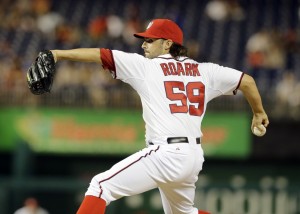 Washington Nationals rookie righthander Tanner Roark has flourished after an August 6 callup. After putting up a 1.19 ERA over 9 games and 22.2 innings in the bullpen, Roark earned his first major league start September 7th. He won that game and his next two starts.
Washington Nationals rookie righthander Tanner Roark has flourished after an August 6 callup. After putting up a 1.19 ERA over 9 games and 22.2 innings in the bullpen, Roark earned his first major league start September 7th. He won that game and his next two starts.
All told, the soon-to-be 27 year-old hurler has managed a sparkling 7-0 record and a 1.08 ERA in 41.2 innings, holding opponents to a .181 batting average. Given his impressive debut, albeit in a limited sample, Nationals fans have to wonder where Roark fits in the team’s plans for 2014 and beyond.
Roark was a former 25th round pick of the Texas Rangers in 2008, and came to the Nationals in 2010 along with Ryan Tatusko in exchange for Cristian Guzman. He features a fastball in the low to mid-nineties. His slider is his best secondary pitch, and he also mixes in a curveball and changeup. His minor league numbers are solid but unspectacular. Over six seasons, Roark has a 4.04 ERA, a 7.7 K/9 and a 2.8 BB/9.
However, that still leaves him with a very solid 3.18 xFIP and 2.16 FIP. His strikeout rate of 20.9% and walk rate of 5.9% are also very good. Still, I have reason to believe that Roark’s ceiling is much lower than these peripheral numbers would indicate.
Roark’s Zone-Contact% is 94.0. When Roark throws a pitch in the zone and hitters swing, they are only missing 6% of the time. Since Pitch f/x began tracking this statistic in 2008, only five pitchers that have thrown 40 or more innings are worse at generating whiffs in the zone.
Those pitchers are Mark Redman, Shane Loux, Eddie Bonine, Doug Mathis, and Enerio del Rosario. First of all, Enerio del Rosario is an awesome name. Second of all, none of these five pitchers are currently in the majors.
Even Sidney Ponson, Glendon Rusch, and Jeff Suppan were able to miss bats more frequently than Roark. In contrast, some of the pitchers with the lowest Z-Contact rates are Cole Hamels, Justin Verlander, Max Scherzer, and Roark’s teammate, Stephen Strasburg. On all pitches, Roark’s swinging strike rate is just 6%, well below the MLB average.
Even with Roark’s limited major league innings, we can begin to have confidence in his ability (or lack thereof) to miss bats, certainly moreso than we can have confidence in his K-rate, his BB-rate, or his ability to prevent hits on balls in play.
Though he’s a rookie, pitchers typically begin declining around their age-27 season. Despite an impressive start and good control, Roark probably has the ceiling of a Nick Blackburn or Scott Diamond, a second division #5 starter.
